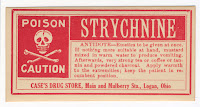 |
| Grizzly Bear Trap from The Newhouse Trappers Guide, 1914. |
Bayard Taylor, 1849: "We had no other arms than pistols and knives and no horses of sufficient fleetness to have ventured an attack with safety; so we passed on with many a wistful and lingering look, for the gray hide of one of those huge beasts would have been a trophy well worth the capture."
 Besides traps, poisons, such as strychnine and phosphorus, were also used. Often a grizzly would not eat an entire animal in one sitting but come back the next day to finish it off.
Besides traps, poisons, such as strychnine and phosphorus, were also used. Often a grizzly would not eat an entire animal in one sitting but come back the next day to finish it off.The left remains would be poisoned in anticipation of the grizzly’s return. See the blog post: Treed by a Dead Bear.
Santa Cruz Weekly Sentinel,1872: "Some twenty [bears] have been killed in this county recently, in that way. Mr Miller returned to his ranch yesterday with four bottles of strychnine to cure bear meat, he having previously fought three bears from a tree in his oat field, and had only an ax to keep the old she bear and her cubs from climbing the tree."
Santa Cruz Weekly Sentinel, 1872: "Varments of the grizzly tribe are peculiar, and the best medicine we can think of is Mrs. Winlow’s soothing syrup, especially for the cubs, when they set up that hideous howl so graphically described. For the older ones, Galena pills [lead shot] – 16 to the pound – from Dr. Henry’s repeater or the Parker gun with good strong powder would no doubt be potent, but in case of failure, try strychnine."
Mrs. Winslow’s syrup contained morphine and was responsible for the drug addition and death from overdose of countless infants and children.
A Text Book for the Professional Teacher, 1910: "The Food Department of the United States has established a list of medical preparations, “soothing syrups,” which are referred to as “baby-killers.” The use of this class of products is certainly to be condemned, and the list as given by the United States Government chemists includes the following preparations: Mrs. Winslow's Soothing Syrup (morphine sulfate)."


